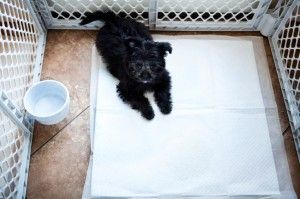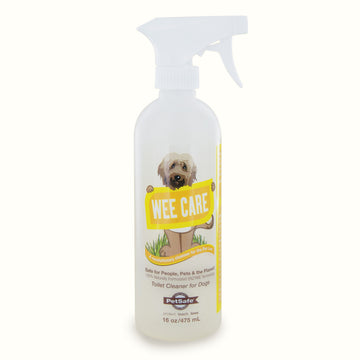By Michelle Mullins, CPDT-KA, Training and Behavior Education Department Manager 
Most people think outside potty training is the only option for their dog. However, you can also train your dog to eliminate inside
While most people think potty training a dog always involves teaching the dog to eliminate outside, in some situations going outside is either extremely difficult or impossible. Limited mobility, illness, or little to no access to outdoor space can make training a dog to use an appropriate indoor area the best option. Think long term when choosing indoors as this needs to be a consistent and permanent change. It is difficult for the dog to change back to outdoors or alternate between indoors and outdoors.
Indoor potty training does have a few considerations:
- You must provide an area indoors with adequate space and convenience for the dog to eliminate
- Cleaning the area to control odor and avoid tracking will require extra effort
- Indoor elimination materials like pads, real sod, artificial turf cleaning materials will be an added expense
Training your dog to eliminate in an appropriate indoor area is the goal and providing an area that is different from any other surface will make a clear distinction for the dog and aid the training. A dog needs to be taught it is rewarding to eliminate in an approved area so set up the area and be consistent in leading the dog to the area for potty breaks.
Both puppies and adult dog can be house trained. While the training steps may be the same please note that puppies can only hold their urine for about an hour plus his age in months. So a puppy who is two months old can hold it for about 3 hours maximum. Every dog will be different and activity level, size and development all effect how long before a dog has full bladder control.
Know when your puppy/dog needs to eliminate: Supervision and observation are very important in house training and avoiding inappropriate elimination behaviors. It will take time to house train your dog and how long it takes is directly related to how well you supervise him. Your puppy/dog will need to eliminate after he eats, drinks, plays and wakes up. Maintaining a consistent feeding schedule will help regulate the dog’s elimination schedule. Watch for your dog’s signals that he needs to go – sniffing, circling, approaching the door or a spot he has used before – and take him to the potty area. If he urinates but you know he usually has a bowel movement during this time wait and give him time to finish. If he doesn’t go in several minutes take him from the area and watch him closely. Try again in a few minutes. Keeping notes on his normal elimination schedule can help you be consistent during the early stage of training.
Supervise: The dog should be supervised as much as possible during training. You or a member of the family should be assigned to watch the puppy/dog. That person’s responsibility is to be watching the dog and taking him to potty as needed. If you need to be doing other things while watching your puppy/dog tie a 6-10’ cord around your waist with the other end attached to your dog’s collar. You will be able to go about doing whatever you need to and supervise your puppy at the same time.
Confinement: You will not be able to watch your dog all the time. During the times you cannot supervise, he needs to be confined. It is highly recommended you purchase a crate, use a pen or small area for your puppy/dog and follow the rules for crate training. Your dog’s crate is a “safe place to call his own”. It is his natural instinct to keep his area clean and this can be utilized during the potty training period. Never force your puppy to eliminate in his crate by expecting him "hold it" longer then he is physically able or he may lose the natural instinct to keep his area clean. The area should only be large enough for your dog to stand up, turn around and lie down. If the crate is larger than this, block part of it off until your puppy grows and or he has full bladder control
Reward your puppy for getting it right! Elimination is a normal and rewarding behavior for your dog. I have to “go” is followed by I “went” and now I feel better. Punishing a dog for accidents, marking and urination due to fear or excitement should be avoided as it only teaches them to not eliminate in your presence. Use a leash and lead your dog to the appropriate area. Take him to the area/surface you prefer he eliminates. Don’t play with him and give him attention until after he eliminates. If you notice he is about to go say something like, “Go potty” or Get busy” just before he eliminates. This will eventually be his cue to eliminate. Reward your puppy with praise, a tiny food treat and some play time (take him out of the potty area for play). Reward him every time he eliminates in the appropriate spot. You need reward him the instant he eliminates and the only way you can is to be there when it happens or by having a pee detection/reward system which is there when you can't be and is a great solution!
Accidents Will Happen
There will be accidents during a dog’s lifetime. Don’t yell at or punish your dog for an accident. This could scare him or simply teach him not to eliminate when you are present. It won’t teach him what is correct. If you catch him soiling in an inappropriate spot cue him to go to the potty area or lead him there. If the “accident” happens anyway or you were not there when it happened don’t show any reaction to your dog.
Clean up any areas where accidents have occurred with an odor eliminator/enzyme cleaner to remove any smell that may draw your puppy back to the area. Your veterinarian should be able to recommend a good product. Leaving your puppy for long time periods. Sometimes you may have to leave your dog alone for longer periods of time during house training. You have some options to keep house training on track:
- Leave your puppy in the elimination area or room that is just large enough for sleeping, eating and an elimination area.
- Indicate the elimination area with a litter box of sod (to mimic the outdoors/grass surface), or pee pads, or whatever you are using as the appropriate surface.
If your puppy or dog is not responding to the training or at any time regresses in their training, please see your veterinarian for a possible health related issue.




